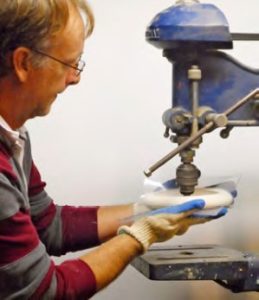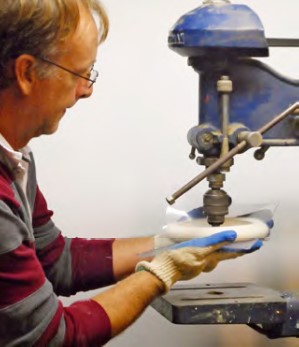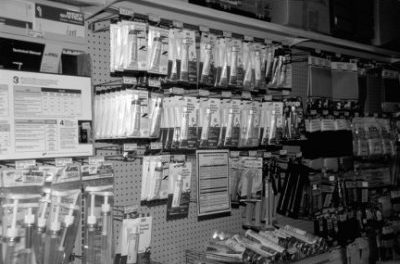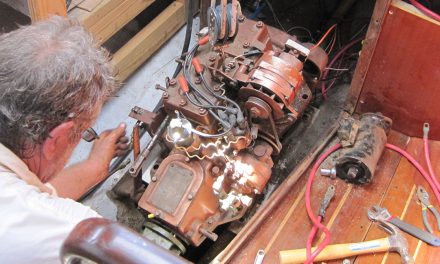Issue 140: Sept/Oct 2021
Buffing can help or hinder. Doing a good job buffing vinyl windows requires considerable effort and patience, and it is quite possible to make things worse. I recommend not trying to buff out a window unless it’s so bad the only alternative is replacement.

Drew does some test buffing on a sheet of clear vinyl.
If you do choose to buff, pay attention to detail. Start with selecting a quality buffing compound. I have been happy with Armada 210+, Sudbury Isin Zoap Polish, EisenShine Stripper (part 2 of the EisenShine Clear Vinyl Restoration Kit), Star brite Step 1, and Novis Step 2. EisenShine was the fastest product, and Isin Zoap was by far the best buy.
Also, I recommend experimenting on an old piece of vinyl first. Ask the canvas shop for a junk dodger from the waste bin to practice on. Get vigorous and see what happens. My first efforts were not impressive.
The tools:
- A plentiful supply of clean cotton or microfiber cloths;
- Lots of towels for padding the work surface;
- Clean wool buffing bonnets, which you will clean frequently (scrub with soap and water) as work progresses. This is a far more delicate process than compounding gel coat, so first and foremost, scrub the buffing bonnets to remove grit, old compound, and wax;
- Two-inch masking tape to protect adjoining canvas;
- Water in a spray bottle;
- Buffer. Low-speed rotary is preferred. A drill is fine.
The procedure:
Do not work in cold weather (below 50°F). You’ll risk cracking the vinyl, especially if it’s older.
Clean the windows with soap and water before you begin; the worst of all possible outcomes is to ruin them with a bit of unseen sand or rust.
Take the dodger or cockpit enclosure panel off the boat and lay it on a flat work area that has been well padded with clean towels. You will be buffing both sides.
Mask dark-colored canvas. While none of the products will damage the fabric, they will leave a ground-in white residue that is challenging to remove. This may not be noticeable with white or off-white canvas or Sunbrella, but the precaution is vital for darker colors. Masking tape is sufficient if you’re careful around the edges.
Choose your weapon, machine or hand polishing. Either is practical, but there are some differences. If the goal is deep cleaning and grime removal with little need for scratch removal, hand polishing works very well on areas up to about 10 square feet. You’ll be working hard on both sides and your arms will feel it. For larger areas, or if you want to remove large areas of fine scratches and scuffs, a buffer can save a lot of physical wear and tear and give better results. I used rotary and orbital buffers and much preferred a low-speed rotary buffer; a hand drill is perfectly adequate for the typical dodger. While some use up to 1,000 rpm, I liked 500 rpm best; the bonnet throws less compound, over-heating is eliminated, and it’s simply more compatible with delicate material. Vinyl is very heat sensitive, and at about 140°F the surface softens and smears, resulting in a marbled surface.
Do nothing without your spray bottle. Never let the work area go dry; if it does, you will melt the vinyl, making things far worse. Use only light pressure tapering to very light, keep moving, and work only as much area as you can keep wet. Moistening the area before it dries can greatly reduce wasteful additions of compound, burning, and over-compounding. Do not try to get everything perfect on the first go. Instead, give the surface a light overall compounding and buff, examine for areas that could use a little more work, and concentrate some effort on them. Then finish with a light overall buffing, wash off any remaining compound, and dry. While deep scratches will be impossible to remove without risking damage to the vinyl, scuffs and very light abrasion—the sort resulting from sloppy storage or a flapping cover—can be removed with extended buffing using light pressure and patience.
Some compounds are better at this than others; Novus Step 2 and Armada 210 Plus worked well, while EisenShine Stripper and Sudbury Isin Zoap Polish were significantly more effective at removing fine scratches. The risk, however, is that a more aggressive compound will increase the panel porosity, potentially increasing fogging and weathering. Yellowing in the surface grime (plasticizer goop) will come right off but yellowing deep in the vinyl will not. I like the less aggressive grits for cleaning and the more aggressive grits when faced with scuffs and fine scratches. The Novus kit came with two grits (1 and 2), and while I played with the coarse grit, it was too much for soft vinyl (the manufacturer does not recommend it for soft vinyl).
One thing to keep in mind about buffing: it will leave your vinyl window more prone to internal fogging in the morning dew. With my test panels, often visibility was reduced to near zero, and it sometimes took hours for the windows to clear. Being a morning person, this was not acceptable to me, and so for this reason alone, I would never buff a window until it was ready for the dumpster.
That said, this fogging can be mitigated with regular use of a sealing protectant that contains wax.
Thank you to Sailrite Enterprises, Inc., for providing free access to back issues of Good Old Boat through intellectual property rights. Sailrite.com





